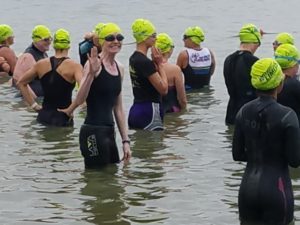“You gain strength, courage, and confidence by every experience in which you really stop to look fear in the face. You are able to say to yourself, ‘I lived through this horror. I can take the next thing that comes along.’ You must do the thing you think you cannot do.”
Eleanor Roosevelt
Fear is a powerful emotion that evokes responses from our mind and body, creating thoughts and physical reactions meant to protect us from danger and emergencies. The same fear response can be triggered by any situation that feels threatening, whether the danger is real or perceived. These thoughts and physical reactions can alter our decision-making or lead us to avoid certain situations altogether.
Conquering fear seems to be both a matter of changing our perception and our response. As Eleanor Roosevelt eloquently stated, with each experience we gain courage and confidence to tackle the next challenge. Therefore, we can learn to change our minds and bodies and become more courageous tackling one fear at a time.
I believe Eleanor Roosevelt is right. I have experienced the transformative power of conquering one fear and using that triumph to overcome the next challenge. This year I found the truth behind her wise statement in what may seem like a trivial endeavor – but a long-held trepidation for me – swimming.
Deep water has always made me nervous, even though I grew up by the Mississippi River, love the ocean and adore gorgeous mountain lakes. But I failed my one and only swim lesson as a five-year-old, and ever since believed I would drown if I found myself in deep water.
During one of the lessons I stood nervously positioning myself to dive into the deep end. The teacher yelled at me to jump, assuring she’d catch me, but as I came sputtering up to the surface she was long gone and left me gasping for air, my arms flailing trying to keep my head above water. I panicked; the sheer terror must have been obvious as another coach swam to me and let me grab onto his arm. That feeling wouldn’t go away and I stayed in the shallow end the rest of the season.
I never learned to swim in deep water and the fear settled into my subconscious. Water was dangerous and threatening and deep water would kill me. Not knowing how to swim made the fears seem real and rational; my perception definitely shaped my response. I avoided deep water all my life.
Diving in
I consider myself an athlete and I have run all lengths of races, cycled many miles and completed a duathlon (biking and running.) A triathlon has always been on my list, but my water phobia kept it out of reach, and it seemed my anxiety intensified with age.
But when my cousin signed up for a local triathlon, I decided it was my time to get over this swimming business. If she was going to do it, I could too. Luckily my husband was a swimmer and offered to coach me. (Yes, he’s a brave soul!) I learned the stroke and mechanics, but the fear of drowning tucked deep in my subconscious did not allow me to relax in the water. I kept hoping it would get easier; I’d somehow find the groove and figure it out. But I was still looking for the groove on my last swim workout before the race.

Let’s just say I was a wee nervous as I stood on the beach watching the elite swimmers start the course – my stomach gurgling and churning, my palms sweaty. I kept looking out at the water and the distance, not totally sure how I was going to make it from one buoy to the next. The fear response was firing hard and my mind was doing its best to rewire the connection.
I started slow and easy not caring about technique, I was just avoiding other legs and arms and focusing on the first buoy. Mentally congratulating myself I paddled around the buoy and set my sights on the next one. It seemed miles away and my arms were starting to burn as I inched my way towards the green swaying marker. I tried not to think of the distance but to just keep moving forward, swimming a few strokes and looking up to make sure I was still on track.
The buoy seemed to get farther away and I started to wonder if I would make it. Panicked, I started treading water, doggie-paddling, front crawling, and doing whatever I could to get closer, but it seemed I was only using up a lot of energy and getting nowhere. I rolled over on my back to take a breather. My mind was racing, telling myself not to stop, but feeling paralyzed by the fear of sinking. I was hitting my wall. The fear was winning. I closed my eyes…and the images came.
Bring it On
I saw the days in the hospital bed, barely able to lift my head off the pillow, shuffling to the bathroom, IV pole in one hand, the other clutching the heart monitor so it didn’t knock against my chest. I saw the nurse asking if I wanted another treatment dose as my throat felt like it was closing up, my skin bloated and red, my body warm with fever and my head throbbing – wanting nothing more than to be outside in the summer sun instead of the sterile hospital – and I somehow nodded my head yes. Yes, I will have another dose.
I felt the chills and shakes as the chemicals flooded my veins, followed by the warm surge of the drugs that took me off to dreamland. I recalled the nausea and diarrhea and the mantra I used to stay sane. Every dose mattered. If I was going to live, I must take another. “Bring it on,” I told myself.
I saw all these images as I brought my arm above my head and back into the water. The gray clouds swirled above me, and I closed my eyes again to wipe away the dizziness. I opened them to see the moving white blanket; my stomach rolling with the chop of the water, I was going to hurl chunks of peanut butter toast and banana into the yellow-green liquid around me. I quickly flipped onto my front and looked around for the nearest kayak. Pulling my legs down I stood up in the deep water hoping a more upright position would keep the contents of my stomach inside.
I told myself, this is not how you are going to disqualify. You are not quitting. If you can handle 52 doses of IL-2, you can swim this. Take a deep breath and relax. You are not going to drown; you know how to swim.
I looked out at the buoy, put my head back in the water and pressed on. As I passed the second marker and made the turn towards shore I knew the end was in sight. Eventually my feet could reach the sandy bottom and I pushed myself out of the water and up the ramp into the transition area to jump on my bike. I made it.

It Gets Easier
In the middle of the reservoir I returned to the mantra I’ve used since those long days in the sub-intensive care unit. If I can face the fear of death and take 52 doses of IL-2, I can do this. Whatever this is. Bring it on.
In this case it was swimming. A few months ago, it was running an ultramarathon. Six months ago, it was signing up for a coaching certification class. Eighteen months ago, it was leaving my dream job to find my true purpose and passion. Now it is owning my own business. Right now it is writing this blog.
As Eleanor Roosevelt stated, “I lived through this horror…I can take the next thing.” The “horror” of cancer gave me courage that I thought was merely the strength to get through the treatments, but thankfully has stretched well beyond those days in the hospital.
With each fear conquered, I come closer to becoming the fearless self I imagine to be. When I need a dose of courage, a dose of inspiration or a dose of kick-ass – I go back to the hospital and say, bring it on. I handled you, I can handle anything. And now I can say the same thing to water!
What’s one thing you think you cannot do? What have you conquered before that you can channel into your next fear-busting challenge? You can do it. Bring it on.
Recent Comments